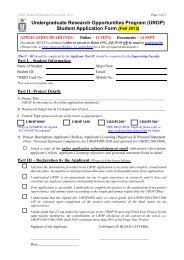UROP Proceedings 2010-11
UROP Proceedings 2010-11
UROP Proceedings 2010-11
You also want an ePaper? Increase the reach of your titles
YUMPU automatically turns print PDFs into web optimized ePapers that Google loves.
Division of Life SciencesSchool of ScienceConstruction of an Odorant Receptor to be Ectopically Expressed inTransgenic AnimalsAdvisor : CHOW King Lau / LIFSStudent : KE Ying / BIOL(<strong>UROP</strong>1000, Summer 20<strong>11</strong>)Caenorhabditis elegans (C. elegans) is a transparent nematode living in soil of temperateenvironment. It normally feeds on bacteria developed on decaying matter. There are two sexesin the species: males and hermaphrodite which can be self-inseminated and lay eggs. Previousstudy shows that males of both C. elegans and C. remanei, can be attracted by sex pheromoneproduced by female C. remanei. There are two sets of neurons related to this behavior in C.elegans: AWA neuron – a sensory neuron located at lateral ganglia of the head of both malesand hermaphrodites; and CEM neuron – a sex specific neuron which is present only in males.The objective of the project is to test whether the CEM neurons are chemosensitive. In orderto achieve the objective, a plasmid was constructed to induce the expression of odr-10 (a genewhich encodes the diacetyl receptor expressed normally only in AWA neuron) in CEM neuron,and give it the ability of sensing diacetyl. The newly constructed plasmid is then injected intothe gonads of hermaphrodites of daf-6, him-5 mutant C. elegans. Since only the CEM neuronsof the transgenic daf-6, him-5 C. elegans could sense the diacetyl and be activated, if thediacetyl assays shows that the transgenic animals are attracted by the diacetyl, it could beconcluded that CEM neurons can function as a chemosensory neuron.The Isolation of Genetic Loci Encoding Negative RegulatorsAntagonizing Bone Morphogenetic Protein Signaling Pathway via aSuppressor Screen with sma-6 MutantsAdvisor : CHOW King Lau / LIFSStudent : XUE Bai / BIOL(<strong>UROP</strong>1000, Summer 20<strong>11</strong>)Caenorhabditis elegans (C. elegans) is often chosen as a model genetic organism, chiefly fortheir hermaphroditic reproductive mode and rapid generation time, making it suitable for theisolation and characterization of genetic mutants. In this project, a specific strain of sma-6(CB1482 sma-6(e1482) II) was used, because it is related with TGF-beta pathway, in whichsma-6 allelel encodes a mild loss-of-function serine / threonine protein kinase that isorthologous to type I TGF-beta receptors. Mutant animals have a mild reduction of bodylength. The objective of this project is to isolate any mutant after EMS (ethyl methanesulfonate), mutagenesis, especially the ones with change in body length phenotype. EMS is amutagen that produces random mutations in the genome by nucleotide substitution. We targetspecifically for mutants that have alteration of body length in this genetic background toisolate potential enhancer mutations and preferably suppressor mutations. Those mutants mayact in the same genetic pathway as facilitator or antagonist molecules.2



